Environmental Factors Determine Tuna Fishing Vessels’ Behavior in Tonga
Abstract
:1. Introduction
2. Materials and Methods
2.1. Catch per Unit Effort Data
2.2. Environmental Data
2.3. Construction and Selection of Models
2.4. Model Selection
3. Results
3.1. Correlation Results
3.2. Spatial Distribution of Tuna Longliners
3.3. Model Training Results
3.4. Prediction Accuracy of the Models
3.5. Contribution Rate of Environmental Factors
4. Discussion
4.1. Environmental Factors and Vessel Data
4.2. The Model’s Goodness-of-Fit
4.3. Influence of Environmental Factors on Vessel Operations
5. Conclusions
Supplementary Materials
Author Contributions
Funding
Data Availability Statement
Acknowledgments
Conflicts of Interest
References
- Krishnan, M.; Lakra, W.S. Coastal and Marine Fisheries Management in. Coast. Mar. Fish. Manag. SAARC Ctries. 2013, 196, 187. [Google Scholar]
- Xu, K.; Feng, J.; Ma, X.; Wang, X.; Zhou, D.; Dai, Z. Identification of tuna species (Thunnini tribe) by PCR-RFLP analysis of mitochondrial DNA fragments. Food Agric. Immunol. 2016, 27, 301–313. [Google Scholar] [CrossRef]
- Takeshima, H.; Yamaura, K.; Kuboshima, N.; Hiramatsu, M.; Kameya, C.; Nohara, K.; Sakuma, K.; Chiba, S.N.; Tawa, A.; Suzuki, N. A method for identifying nine tuna and tuna-like species (tribe Thunnini) by using high-resolution melting analysis based on genotyping single nucleotide polymorphisms in mitochondrial DNA. Conserv. Genet. Resour. 2023, 15, 153–159. [Google Scholar] [CrossRef]
- WCPFC. Overview of Tuna Fisheries in the Western and Central Pacific Ocean, Including Economic Conditions; WCPFC-TCC13-IP0; Secretariat of the Pacific Community (SPC): Noumea, New Caledonia, 2010. [Google Scholar]
- Barclay, K.; Cartwright, I. Governance of tuna industries: The key to economic viability and sustainability in the Western and Central Pacific Ocean. Mar. Policy 2007, 31, 348–358. [Google Scholar] [CrossRef]
- Gillett, R.; McCoy, M.; Rodwell, L.; Tamate, J. Tuna: A Key Economic Resource in the Pacific Islands; A report prepared for the asian development bank and the forum fisheries agency; Asian Development Bank: Mandaluyong, Philippines, 2001; p. 108. [Google Scholar]
- Bell, J.D.; Kronen, M.; Vunisea, A.; Nash, W.J.; Keeble, G.; Demmke, A.; Pontifex, S. Planning the use of fish for food security in the pacific. Mar. Policy 2009, 33, 64–76. [Google Scholar] [CrossRef]
- MAFF; FFA. Tonga Tuna Fishery Framework 2018–2022; Ministry of Agriculture, Forestry; Fisheries, Fishery Forum Agency: Nuku’alofa, Tonga, 2018.
- Collette, B.B.; Carpenter, K.E.; Polidoro, B.A.; Juan-Jordá, M.J.; Boustany, A.; Die, D.J.; Elfes, C.; Fox, W.; Graves, J.; Harrison, L.R.; et al. High value and long life—Double jeopardy for tunas and billfishes. Science 2011, 333, 291–292. [Google Scholar] [CrossRef] [PubMed]
- Juan-Jordá, M.J.; Mosqueira, I.; Cooper, A.B.; Freire, J.; Dulvy, N.K. Global population trajectories of tunas and their relatives. Proc. Natl. Acad. Sci. USA 2011, 108, 20650–20655. [Google Scholar] [CrossRef] [PubMed]
- Wright, G.; Rochette, J.; Gjerde, K.; Seeger, I. The Long and Winding Road: Negotiating a Treaty for the Conservation and Sustainable Use of Marine Biodiversity in Areas beyond National Jurisdiction; IDDRI: Paris, France, 2018. [Google Scholar]
- Roy, A. Blue economy in the Indian Ocean: Governance perspectives for sustainable development in the region. ORF Occas. Pap. 2019, 181, 1–34. [Google Scholar]
- Havice, E.; Campling, L. Shifting tides in the Western and Central Pacific Ocean tuna fishery: The political economy of regulation and industry responses. Glob. Environ. Politics 2010, 10, 89–114. [Google Scholar] [CrossRef]
- Lan, K.-W.; Shimada, T.; Lee, M.A.; Su, N.J.; Chang, Y. Using remote-sensing environmental and fishery data to map potential yellowfin tuna habitats in the tropical pacific ocean. Remote Sens. 2017, 9, 444. [Google Scholar] [CrossRef]
- Yen, K.W.; Lu, H.J.; Chang, Y.; Lee, M.A. Using remote-sensing data to detect habitat suitability for yellowfin tuna in the western and central pacific ocean. Int. J. Remote Sens. 2012, 33, 7507–7522. [Google Scholar] [CrossRef]
- Mainuddin, M.; Saiton, K.; Saiton, S. Albacore fishing ground in relation to oceanographic conditions in the western north pacific ocean using remotely sensed satellite data. Fish. Oceanogr. 2008, 17, 61–73. [Google Scholar] [CrossRef]
- Eveson, J.P.; Hobday, A.J.; Hartog, J.R.; Spillman, C.M.; Rough, K.M. Seasonal forecasting of tuna habitat in the Great Australian Bight. Fish. Res. 2015, 170, 39–49. [Google Scholar] [CrossRef]
- Houssard, P.; Point, D.; Tremblay-Boyer, L.; Allain, V.; Pethybridge, H.; Masbou, J.; Ferriss, B.E.; Baya, P.A.; Lagane, C.; Menkes, C.E.; et al. A model of mercury distribution in tuna from the western and central Pacific Ocean: Influence of physiology, ecology and environmental factors. Environ. Sci. Technol. 2019, 53, 1422–1431. [Google Scholar] [CrossRef]
- Wang, Y.; Liu, J.; Liu, H.; Lin, P.; Yuan, Y.; Chai, F. Seasonal and interannual variability in the sea surface temperature front in the eastern pacific ocean. J. Geophys. Res. Ocean. 2021, 126, e2020JC016356. [Google Scholar] [CrossRef]
- Wiryawan, B.; Loneragan, N.; Mardhiah, U.; Kleinertz, S.; Wahyuningrum, P.I.; Pingkan, J.; Timur, P.S.; Duggan, D.; Yulianto, I. Catch per unit effort dynamic of yellowfin tuna related to sea surface temperature and chlorophyll in Southern Indonesia. Fishes 2020, 5, 28. [Google Scholar] [CrossRef]
- Sambah, A.B.; Muamanah, A.; Harlyan, L.I.; Lelono, T.D.; Iranawati, F.; Sartimbul, A. Sea surface temperature and chlorophyll-a distribution from Himawari satellite and its relation to yellowfin tuna in the Indian Ocean. Aquac. Aquar. Conserv. Legis. 2021, 14, 897–909. [Google Scholar]
- Hidayat, R.; Zainuddin, M.; Putri, A.R.S. Skipjack tuna (Katsuwonus pelamis) catches in relation to chlorophyll-a front in bone gulf during the southeast monsoon. Aquac. Aquar. Conserv. Legis. 2009, 12, 209–218. [Google Scholar]
- Maravelias, C.D. Habitat selection and clustering of a pelagic fish: Effects of topography and bathymetry on species dynamics. Can. J. Fish. Aquat. Sci. 1999, 56, 437–450. [Google Scholar] [CrossRef]
- Lumban-Gaol, J.; Leben, R.R.; Vignudelli, S.; Mahapatra, K.; Okada, Y.; Nababan, B.; Mei-Ling, M. Variability of satellite-derived sea surface height anomaly, and its relationship with bigeye tuna (Thunnus obesus) catch in the eastern indian ocean. Eur. J. Remote Sens. 2015, 48, 465–477. [Google Scholar] [CrossRef]
- Teo, S.L.; Block, B.A. Comparative influence of ocean conditions on yellowfin and atlantic bluefin tuna catch from longlines in the gulf of mexico. PLoS ONE 2010, 5, e10756. [Google Scholar] [CrossRef] [PubMed]
- Wexler, J.B.; Margulies, D.; Scholey, V.P. Temperature and dissolved oxygen requirements for survival of yellowfin tuna, Thunnus albacares, larvae. J. Exp. Mar. Biol. Ecol. 2011, 404, 63–72. [Google Scholar] [CrossRef]
- Ganachaud, A.; Sen Gupta, A.; Brown, J.N.; Evans, K.; Maes, C.; Muir, L.C.; Graham, F.S. Projected changes in the tropical Pacific Ocean of importance to tuna fisheries. Clim. Chang. 2013, 119, 163–179. [Google Scholar] [CrossRef]
- Cornic, M.; Rooker, J.R. Influence of oceanographic conditions on the distribution and abundance of blackfin tuna (Thunnus atlanticus) larvae in the Gulf of Mexico. Fish. Res. 2018, 201, 1–10. [Google Scholar] [CrossRef]
- Reimer, M.N.; Abbott, J.K.; Wilen, J.E. Fisheries production: Management institutions, spatial choice, and the quest for policy invariance. Mar. Resour. Econ. 2017, 32, 143–168. [Google Scholar] [CrossRef]
- Lacoursière-Roussel, A.; Côté, G.; Leclerc, V.; Bernatchez, L. Quantifying relative fish abundance with eDNA: A promising tool for fisheries management. J. Appl. Ecol. 2016, 53, 1148–1157. [Google Scholar] [CrossRef]
- Crespo, G.O.; Dunn, D.C.; Reygondeau, G.; Boerder, K.; Worm, B.; Cheung, W.; Tittensor, D.P.; Halpin, P.N. The environmental niche of the global high seas pelagic longline fleet. Sci. Adv. 2018, 4, 3681. [Google Scholar] [CrossRef]
- Juan-Jordá, M.J.; Murua, H.; Arrizabalaga, H.; Dulvy, N.K.; Restrepo, V. Report card on ecosystem-based fisheries management in tuna regional fisheries management organizations. Fish Fish. 2018, 19, 321–339. [Google Scholar] [CrossRef]
- Crowder, L.; Norse, E. Essential ecological insights for marine ecosystem-based management and marine spatial planning. Mar. Policy 2008, 32, 772–778. [Google Scholar] [CrossRef]
- Granek, E.F.; Polasky, S.; Kappel, C.V.; Reed, D.J.; Stoms, D.M.; Koch, E.W.; Kennedy, C.J.; Cramer, L.A.; Hacker, S.D.; Barbier, E.B.; et al. Ecosystem services as a common language for coastal ecosystem-based management. Conserv. Biol. 2010, 24, 207–216. [Google Scholar] [CrossRef]
- Espinosa-Romero, M.J.; Chan, K.M.; McDaniels, T.; Dalmer, D.M. Structuring decision-making for ecosystem-based management. Mar. Policy 2011, 35, 575–583. [Google Scholar] [CrossRef]
- Ochiewo, J. Changing fisheries practices and their socioeconomic implications in South Coast Kenya. Ocean. Coast. Manag. 2004, 47, 389–408. [Google Scholar] [CrossRef]
- Eliasen, S.Q.; Papadopoulou, K.N.; Vassilopoulou, V.; Catchpole, T.L. Socio-economic and institutional incentives influencing fishers’ behaviour in relation to fishing practices and discard. ICES J. Mar. Sci. 2014, 71, 1298–1307. [Google Scholar] [CrossRef]
- Su, F.; Zhou, C.; Lyne, V.; Du, Y.; Shi, W. A data-mining approach to determine the spatio-temporal relationship between environmental factors and fish distribution. Ecol. Model. 2004, 174, 421–431. [Google Scholar] [CrossRef]
- Murray, G.; Neis, B.; Johnsen, J.P. Lessons learned from reconstructing interactions between local ecological knowledge, fisheries science, and fisheries management in the commercial fisheries of Newfoundland and Labrador, Canada. Hum. Ecol. 2006, 34, 549–571. [Google Scholar] [CrossRef]
- Orben, R.A.; Adams, J.; Hester, M.; Shaffer, S.A.; Suryan, R.M.; Deguchi, T.; Ozaki, K.; Sato, F.; Young, L.C.; Clatterbuck, C.; et al. Across borders: External factors and prior behaviour influence North Pacific albatross associations with fishing vessels. J. Appl. Ecol. 2021, 58, 1272–1283. [Google Scholar] [CrossRef]
- Hsu, T.Y.; Chang, Y.; Lee, M.A.; Wu, R.F.; Hsiao, S.C. Predicting skipjack tuna fishing grounds in the western and central Pacific Ocean based on high-spatial-temporal-resolution satellite data. Remote Sens. 2021, 13, 861. [Google Scholar] [CrossRef]
- Wang, W.; Zhou, C.; Shao, Q.; Mulla, D. Remote sensing of sea surface temperature and chlorophyll-a: Implications for squid fisheries in the north-west pacific ocean. Int. J. Remote Sens. 2010, 31, 4515–4530. [Google Scholar] [CrossRef]
- Arrizabalaga, H.; Dufour, F.; Kell, L.; Merino, G.; Ibaibarriaga, L.; Chust, G. Global habitat preferences of commercially valuable tuna. Deep Sea Res. Part II Top. Stud. Oceanogr. 2015, 113, 102–112. [Google Scholar] [CrossRef]
- Zhou, W.F.; Chen, L.L.; Cui, X.S.; Zhang, H. Influence of Thermocline and Spatiotemporal Factors on the Distribution of Yellowfin Tuna Fishing Grounds in the Central and Western Pacific Under Abnormal Climate. China Agric. Sci. Technol. Rev. 2021, 23, 192–201. [Google Scholar]
- Yang, S.L.; Shi, H.M.; Fan, X.M.; Cui, X.S.; Wang, F.; Zhang, H. Spatial Analysis of the Habitat of Yellowfin Tuna in the Tropical Central and Western Pacific. China Agric. Sci. Technol. Herald. 2022, 24, 183–191. [Google Scholar] [CrossRef]
- Dell, J.; Wilcox, C.; Hobday, A.J. Estimation of yellowfin tuna (Thunnus albacares) habitat in waters adjacent to australia’s east coast: Making the most of commercial catch data. Fish. Oceanogr. 2011, 20, 383–396. [Google Scholar] [CrossRef]
- Nicolas, B.; Walker, E.; Gaertner, D.; Rivoirard, J.; Gaspar, P. Fishing Activity of Tuna Purse Seinersestimated From Vessel Monitoring System (VMS) Data. Can. J. Fish. Aquat. Sci. 2011, 68, 1998–2010. [Google Scholar]
- Zhang, C.L.; Jiang, Y.; Wang, B.Y.; Wang, D.Y.; Hu, S. Construction and Preliminary Analysis of the Vertical Temperature Structure of the Accompanying Fish School of Yellowfin Tuna in the Central and Western Pacific. J. Shanghai Ocean Univ. 2021, 33, 233–241. [Google Scholar]
- Oyafuso, Z.S.; Drazen, J.C.; Moore, C.H.; Franklin, E.C. Habitat-based species distribution modelling of the Hawaiian deepwater snapper-grouper complex. Fish. Res. 2017, 195, 19–27. [Google Scholar] [CrossRef]
- Stock, B.C.; Ward, E.J.; Eguchi, T.; Jannot, J.E.; Thorson, J.T.; Feist, B.E.; Semmens, B.X. Comparing predictions of fisheries bycatch using multiple spatiotemporal species distribution model frameworks. Can. J. Fish. Aquat. Sci. 2020, 77, 146–163. [Google Scholar] [CrossRef]
- Vaihola, S.; Yemane, D.; Kininmonth, S. Spatiotemporal Patterns in the Distribution of Albacore, Bigeye, Skipjack, and Yellowfin Tuna Species within the Exclusive Economic Zones of Tonga for the Years 2002 to 2018. Diversity 2023, 15, 1091. [Google Scholar] [CrossRef]
- Zhang, T.; Song, L.; Yuan, H.; Song, B.; Ebango Ngando, N. A comparative study on habitat models for adult bigeye tuna in the Indian Ocean based on gridded tuna longline fishery data. Fish. Oceanogr. 2021, 30, 584–607. [Google Scholar] [CrossRef]
- Maunder, M.N.; Punt, A. Standardizing catch and effort data: A review of recent approaches. Fish. Res. 2004, 70, 141–159. [Google Scholar] [CrossRef]
- Mugo, R.; Saitoh, S.I.; Nihira, A.; Kuroyama, T. Habitat characteristics of skipjack tuna (Katsuwonus pelamis) in the western North Pacific: A remote sensing perspective. Fish. Oceanogr. 2010, 19, 382–396. [Google Scholar] [CrossRef]
- Martinez, L.A.; Harris, W.S.; Lee, D.Y. Assessing the importance of catch per unit effort in tuna distribution models for effective fisheries management. J. Ocean Fish. Stud. 2021, 37, 105–119. [Google Scholar]
- Smith, J.R.; Johnson, M.K.; Thompson, P.Q. The role of catch per unit effort in modeling tuna distribution: Implications for sustainable fisheries management. Mar. Biol. Fish. Res. 2022, 54, 321–334. [Google Scholar]
- Assis, J.; Tyberghein, L.; Bosch, S.; Verbruggen, H.; Serrão, E.A.; De Clerck, O.; Tittensor, D. Bio-ORACLE v2.0: Extending marine data layers for bioclimatic modelling. Glob. Ecol. Biogeogr. 2018, 27, 277–284. [Google Scholar] [CrossRef]
- Lüdecke, D.; Ben-Shachar, M.S.; Patil, I.; Waggoner, P.; Makowski, D. performance: An R package for assessment, comparison and testing of statistical models. J. Open. Source Softw. 2021, 6, 3139. [Google Scholar] [CrossRef]
- Naimi, B.; Hamm, N.; Groen, T.A.; Skidmore, A.K.; Toxopeus, A.G. Where is positional uncertainty a problem for species distribution modelling. Ecography 2014, 37, 191–203. [Google Scholar] [CrossRef]
- R Development Core Team. R: A Language and Environment for Statistical Computing. Vienna, R Foundation for Statistical Computing. 2018. Available online: https://www.R-project.org/ (accessed on 9 April 2019).
- Naimi, B.; Araújo, M.B. SDM: A reproducible and extensible r platform for species distribution modelling. Ecography 2016, 39, 368–375. [Google Scholar] [CrossRef]
- Stramma, L.; Prince, E.D.; Schmidtko, S.; Luo, J.; Hoolihan, J.P.; Visbeck, M.; Wallace, D.W.; Brandt, P.; Körtzinger, A. Expansion of oxygen minimum zones may reduce available habitat for tropical pelagic fishes. Nat. Clim. Chang. 2012, 2, 33–37. [Google Scholar] [CrossRef]
- Tidd, A.N.; Hutton, T.; Kell, L.T.; Blanchard, J.L. Dynamic prediction of effort reallocation in mixed fisheries. Fish. Res. 2012, 125, 243–253. [Google Scholar] [CrossRef]
- Stevenson, T.C.; Tissot, B.N.; Walsh, W.J. Socioeconomic consequences of fishing displacement from marine protected areas in Hawaii. Biol. Conserv. 2013, 160, 50–58. [Google Scholar] [CrossRef]
- Setiawati, M.D.; Sambah, A.B.; Miura, F.; Tanaka, T.; As-syakur, A.R. Characterization of bigeye tuna habitat in the Southern Waters off Java–Bali using remote sensing data. Adv. Space Res. 2015, 55, 732–746. [Google Scholar] [CrossRef]
- Tseng, C.T.; Sun, C.L.; Yeh, S.Z.; Chen, S.C.; Su, W.C. Spatio-temporal distributions of tuna species and potential habitats in the Western and Central Pacific Ocean derived from multi-satellite data. Int. J. Remote Sens. 2010, 31, 4543–4558. [Google Scholar] [CrossRef]
- Megan, A.C.; Anderson, M.; Schramek, T.; Merrifield, S.; Terrill, E.J. Towards a Fishing Pressure Prediction System for a Western Pacific EEZ. Sci. Rep. 2019, 9, 461–470. [Google Scholar]
- Huang, J.L.; Dai, L.B.; Wang, X.F.; Zhou, C.; Tang, H. Spatial and Temporal Distribution Characteristics of Habitat Preference of Free-Swarming Tuna in the Eastern Pacific Ocean. J. Shanghai Ocean Univ. 2020, 29, 889–898. [Google Scholar]
- Nataniel, A.; Lopez, J.; Soto, M. Modelling Seasonal Environmental Preferences of Tropical Tuna Purse Seine Fisheries in the Mozambique Channel. Fish. Res. 2021, 243, 106073. [Google Scholar] [CrossRef]
- Mallya, Y.J. The effects of dissolved oxygen on fish growth in aquaculture. In The United Nations University Fisheries Training Programme, Final Project; United Nations University: Reykjavik, Iceland, 2007. [Google Scholar]
- Song, L.; Zhou, Y. Developing an integrated habitat index for bigeye tuna (Thunnus obesus) in the Indian Ocean based on longline fisheries data. Fish. Res. 2010, 105, 63–74. [Google Scholar] [CrossRef]
- Yang, X.M.; Dai, X.J.; Tian, S.Q.; Zhu, G.P. Hot Spot Analysis and Spatial Heterogeneity of Bonito Purse Seine Fishery Resources in the Central and Western Pacific. Chin. J. Ecol. 2014, 34, 3771–3778. [Google Scholar]
- Stoner, A.W. Effects of environmental variables on fish feeding ecology: Implications for the performance of baited fishing gear and stock assessment. J. Fish. Biol. 2004, 65, 1445–1471. [Google Scholar] [CrossRef]
- Tang, F.H.; Cui, X.S.; Yang, S.L.; Zhou, W.F.; Cheng, T.F.; Wu, Z.L. GIS Spatiotemporal Analysis of the Impact of Marine Environment on the Western and Central Pacific Ocean Tuna Purse Seine Fishing Grounds. South. Fish. Sci. 2014, 10, 18–26. [Google Scholar]
- Putri, A.R.S.; Zainuddin, M.; Musbir, M.; Mustapha, M.A.; Hidayat, R.; Putri, R.S. Impact of increasing sea surface temperature on skipjack tuna habitat in the Flores Sea, Indonesia. IOP Conf. Ser. Earth Environ. Sci. 2021, 763, 012012. [Google Scholar] [CrossRef]
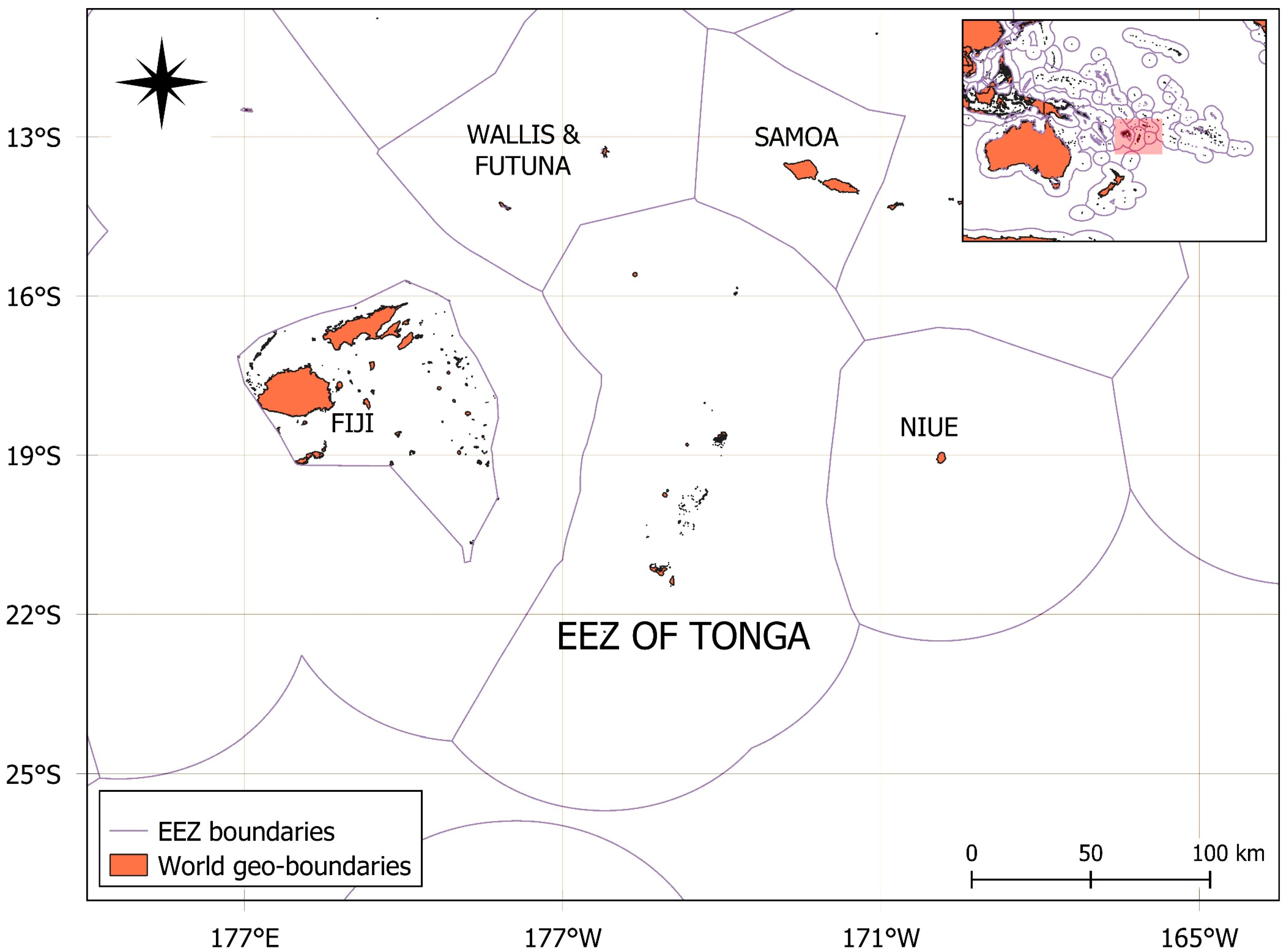
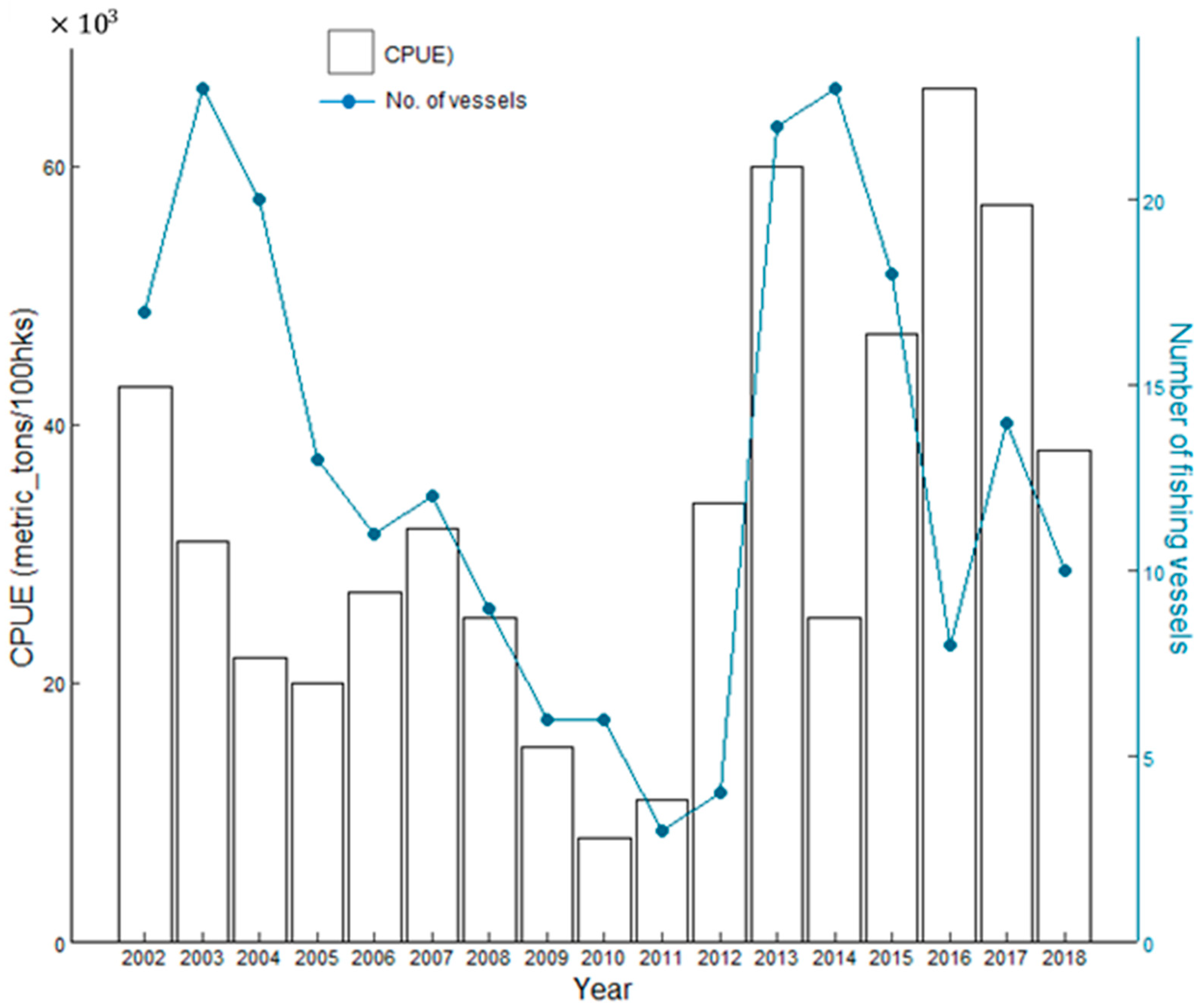
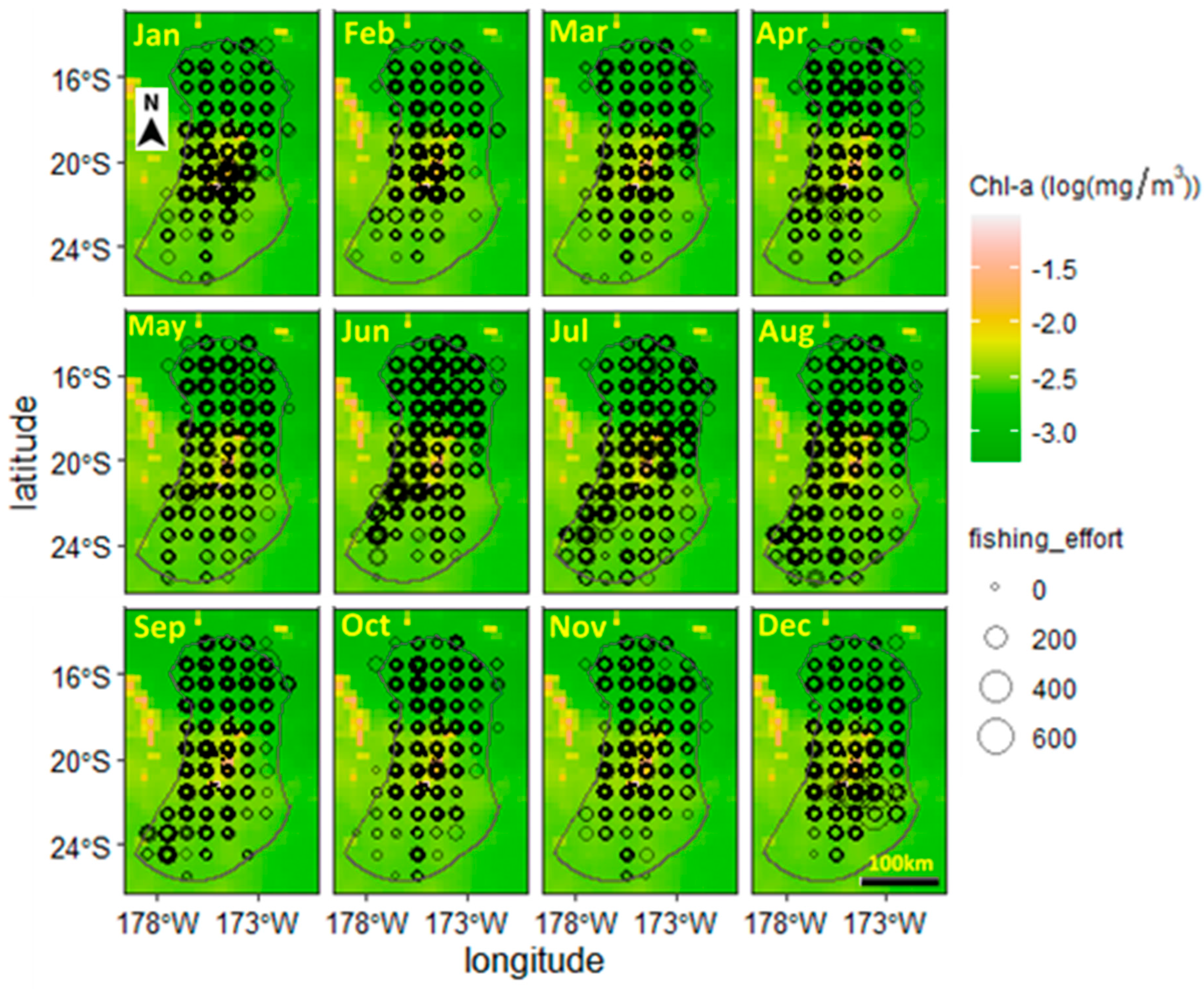
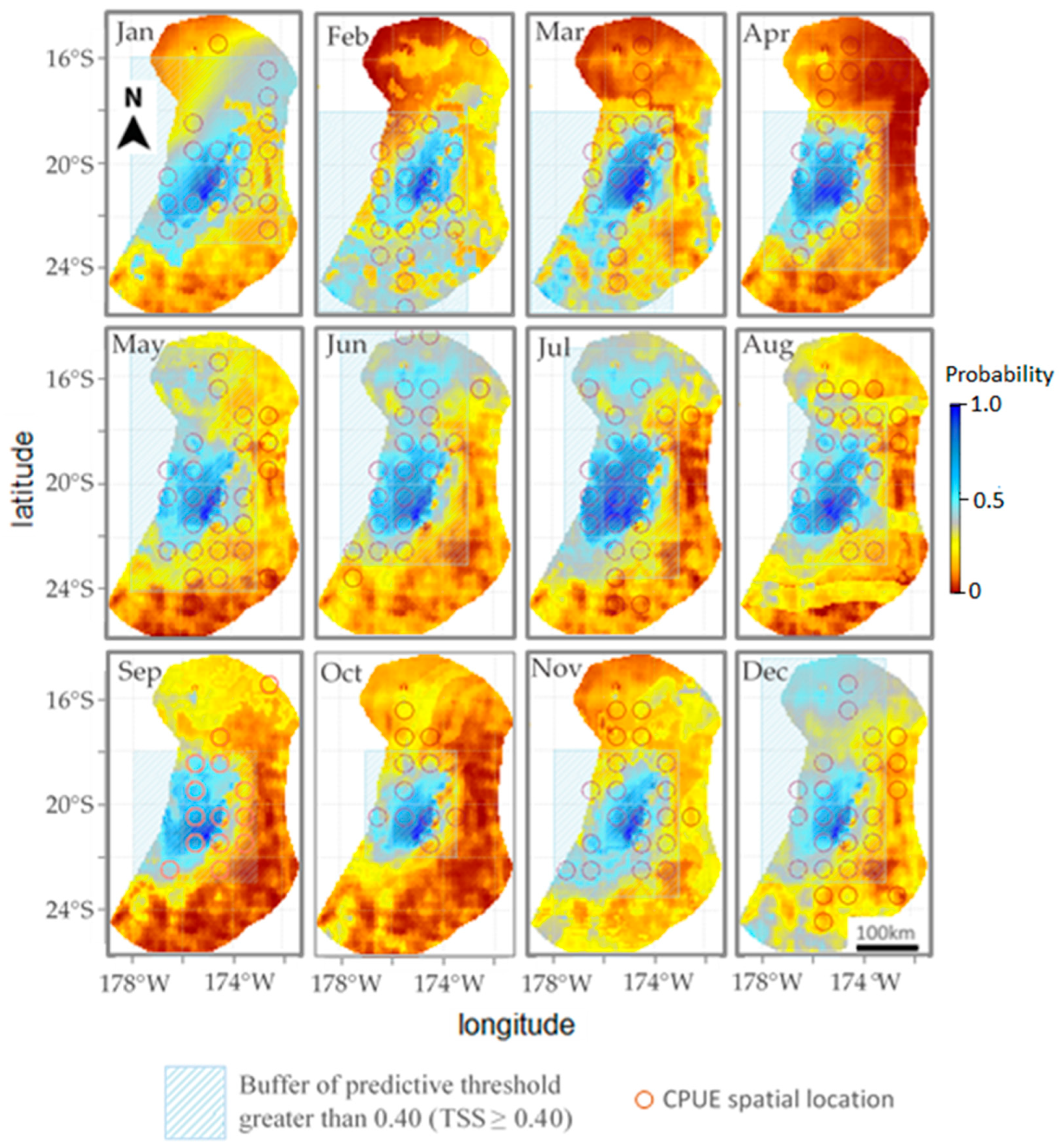
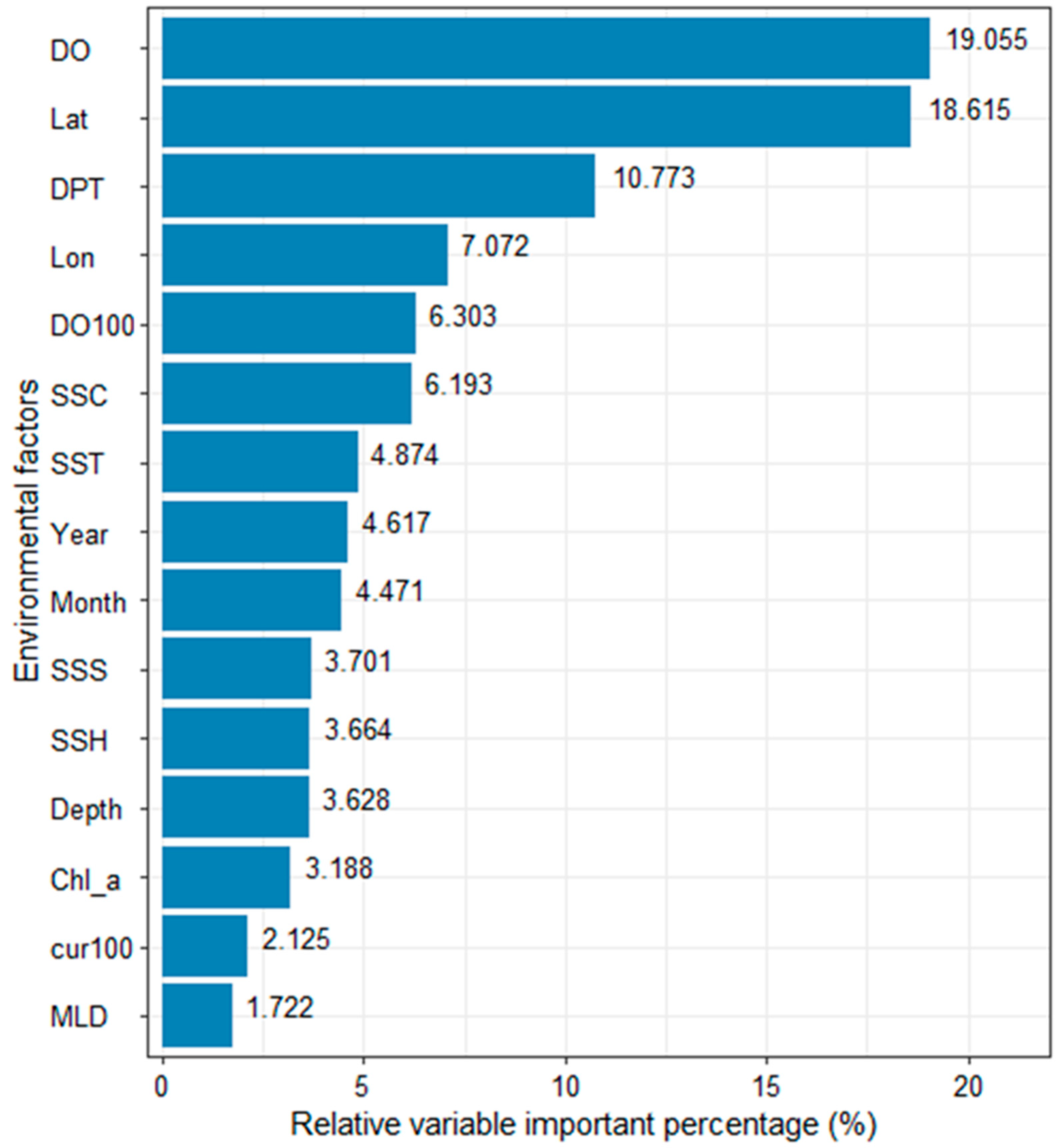
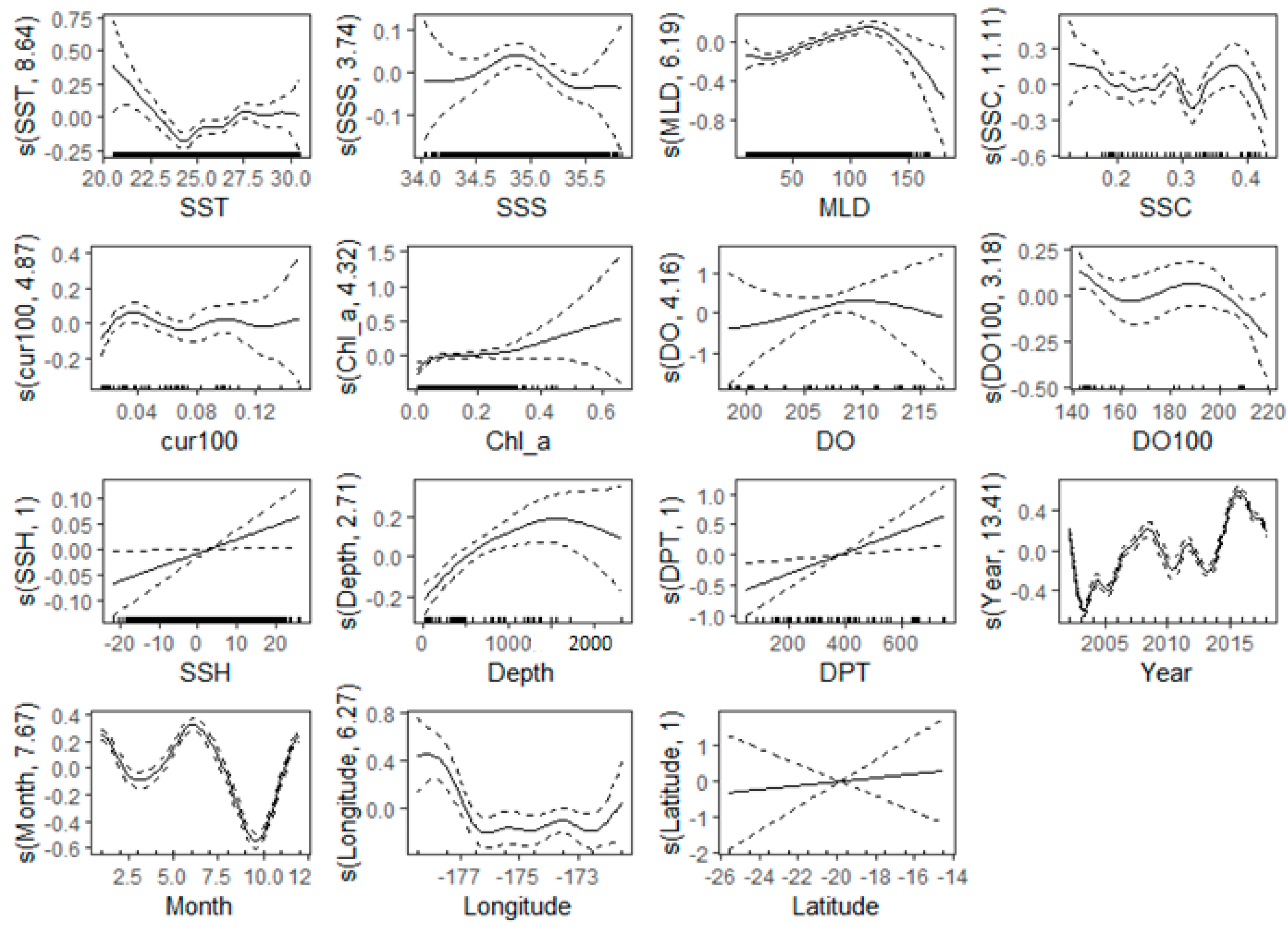
| Abbreviations | Variable Explained | Unit |
|---|---|---|
| SST | Sea surface temperature | °C |
| SSH | Sea surface height | M |
| SSS | Sea surface salinity | PSU |
| MLD | Mixed layer depth | m |
| SSC | Sea surface current (zonal current) | ms−1 |
| Chl-a | Sea surface chlorophyll | mg m−3 |
| DO | Dissolved oxygen | mmol m−3 |
| cur100 | Current velocity at 100 m depth | ms−1 |
| temp100 | Temperature at 100 m depth | °C |
| DO100 | Dissolved oxygen at 100 m depth | m |
| chl100 | Chlorophyll concentration at 100 m | mg m−3 |
| salt100 | Salinity at 100 m depth | PSU |
| Depth | Bathymetry | m |
| DPT | Distance to port | km |
Disclaimer/Publisher’s Note: The statements, opinions and data contained in all publications are solely those of the individual author(s) and contributor(s) and not of MDPI and/or the editor(s). MDPI and/or the editor(s) disclaim responsibility for any injury to people or property resulting from any ideas, methods, instructions or products referred to in the content. |
© 2023 by the authors. Licensee MDPI, Basel, Switzerland. This article is an open access article distributed under the terms and conditions of the Creative Commons Attribution (CC BY) license (https://creativecommons.org/licenses/by/4.0/).
Share and Cite
Vaihola, S.; Kininmonth, S. Environmental Factors Determine Tuna Fishing Vessels’ Behavior in Tonga. Fishes 2023, 8, 602. https://doi.org/10.3390/fishes8120602
Vaihola S, Kininmonth S. Environmental Factors Determine Tuna Fishing Vessels’ Behavior in Tonga. Fishes. 2023; 8(12):602. https://doi.org/10.3390/fishes8120602
Chicago/Turabian StyleVaihola, Siosaia, and Stuart Kininmonth. 2023. "Environmental Factors Determine Tuna Fishing Vessels’ Behavior in Tonga" Fishes 8, no. 12: 602. https://doi.org/10.3390/fishes8120602
APA StyleVaihola, S., & Kininmonth, S. (2023). Environmental Factors Determine Tuna Fishing Vessels’ Behavior in Tonga. Fishes, 8(12), 602. https://doi.org/10.3390/fishes8120602







